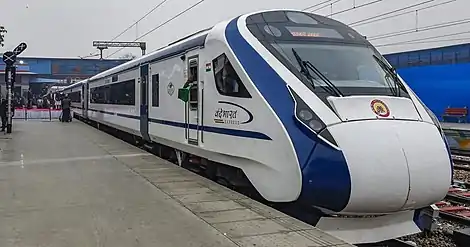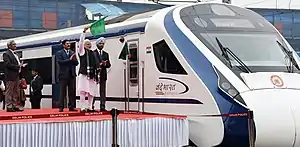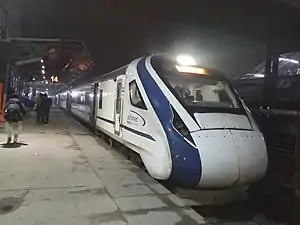Vande Bharat Express
Vande Bharat Express, also known as Train 18,[1] is an Indian high-speed rail intercity network for electric multiple unit.[2] It was designed and built by Integral Coach Factory (ICF) at Perambur, Chennai under the Indian government's Make in India initiative over a span of 18 months. The unit cost of the first rake was given as ₹1 billion (US$14 million), though the unit cost is expected to go down with subsequent production.[3] At the original price, it is estimated to be 40% cheaper than a similar train imported from Europe.[4] The train was launched on 15 February 2019,[5] by which date a second unit will have been produced and readied for service.[6] The service was named 'Vande Bharat Express' on 27 January 2019.[7] As of July 2020, the Indian Railways operates two Vande Bharat trains.[8] In January 2021, Indian Railways finally awarded the contract for supply of propulsion and control equipment of 44 rakes to Medha Servo Drives, based at Hyderabad.[9]
| Vande Bharat Express | |
|---|---|
 | |
| Overview | |
| Status | Active |
| First service | 23 February 2019 |
| Current operator(s) | IRCTC |
| Website | http://indianrail.gov.in |
| On-board services | |
| Class(es) | AC chair car Executive Chair Car |
| Seating arrangements | Yes |
| Sleeping arrangements | No |
| Catering facilities | On-board catering |
| Observation facilities | Large windows in all carriages |
| Entertainment facilities | Electric outlets |
| Baggage facilities | Overhead racks |
| Other facilities | Automatic doors Smoke alarms CCTV Cameras Odour control system Sensor based water taps |
| Technical | |
| Rolling stock | LHB rake |
| Track gauge | Indian gauge 1,676 mm (5 ft 6 in) Broad Gauge |
| Average length | 376.64 metres (1,235.7 ft) |
Vande Bharat Express has capable operation speeds is up to 180 km/h, but the actual top speed is only 130 km/h due to speed limit of railway track of routes which used by Vande Bharat Express.[10][11]
Design and development
Train 18's exterior appearance consists of aerodynamic narrowing at each ends of the train.[12] It has a driver coach at each end of the train, allowing for faster turnaround at each end of the line.[13] The train has 16 passenger cars, with a seating capacity of 1,128 passengers.[14] Two of the center compartments are first class compartments that seat 52 each, with the rest being coach compartments seating 78 each.[15]
The train's seats, braking system, doors, and transformers are the only elements of the train to be outsourced,[3] with plans to make them domestically on the production of the next unit.[16] Train 18 employs a regenerative braking system.[17]
Another unit is planned for production over the year 2020, along with four more units in 2021, for a total of six.[12] The Railway Board has requested that ICF complete two of the new units by May 2019.[17] [18] "As per the production programme issued by the Railway Board, this includes the second train coming out after the elections and third by October this year. After October, ICF will make one train every alternate month till March 2020 and one rake every month from April 2020."According to the Ministry of Railways earlier this year, Modern Coach Factory (MCF), Raebareli which has been a shining example of 'Make in India', will also manufacture more Vande Bharat Express train sets in the coming months.
Based on Vande Bharat Express, Train 19 was a proposed higher-speed, long distance electric multiple unit, manufactured by ICF. It was supposed to have sleeper coaches instead of seats, unlike Train 18.[19][20][21]
Indian Railways and ICF are also planning the development of Train 20, another semi-high speed train that will replace the Rajdhani Express. The line is supposed to be unveiled in 2020.[22]
Indian Railways plans to order 40 train sets of Train 18 by 2022 with modified cabin crash guard made out of aluminium along with lithion-ion battery.[23][24]
Trial runs
The train's first trial run occurred on 29 October 2018 in Chennai,[13] focusing on crew orientation and testing the train's brakes,[18] with further testing scheduled to be done in Delhi on 7 November and later in Rajasthan.[16] An Indian Railways official reported that "some fuses went off" during the trial in Chennai, but that the issue was minor and quickly fixed.[25] The train ended up leaving for Delhi later than expected, on 11 November, and arrived on 13 November.[25] Testing was set to commence along a section of track between Bareilly and Moradabad in Uttar Pradesh on 17 November,[26] but the location was subsequently changed to the stretch of rail between Moradabad and Rampur due to unspecified issues with the initial section of track.[27] The Moradabad–Rampur testing occurred at low speeds ranging from 30–60 km/h (19–37 mph).[28] After the lower-speed testing, the train was moved to a section of track between Kota and Sawai Madhopur to be tested at operating speed.[26] During its trials, Train 18 reached speeds of 180 km/h (110 mph), the highest speed any train in India has reached in the trials but they restricted the speed to 130 km/h officially.[29]
A team put together by India's Research Design and Standards Organisation will supervise the testing and give the go-ahead for the final speed test.[30]
On 20 December 2018, a window of the train was smashed by a thrown stone and the glass shattered while it was on its trial run from Delhi to Agra.[31][32]
A few countries have shown interest in importing models of the train due to its lower cost.[33][34]
Inaugural run and entry into service


The train flagged off for an inaugural run by Prime Minister of India Narendra Modi, on 15 February 2019,[35] with its commercial run started from 17 February 2019 onwards. It will be running on the Delhi-Varanasi route,[15] via Kanpur and Prayagraj, connecting the holy city of Varanasi to the Capital city, reducing travel time along the route by 15 percent.[2] The train's regenerative brakes are also expected to allow a 30% savings in electricity costs as compared to its predecessor.[36] At an operating speed of 160 kilometres per hour (99 mph), it will outpace the Shatabdi Express by 30 kilometres per hour (19 mph).[15] Although the trainset has been tested for speeds up to 180 km/h, operational speed has been capped at 130 km/h as an internal report by Indian Railways indicated that just 0.3% of the country's track is capable of supporting speeds of that magnitude.[37] Every other car on the train is motorised.[13] The 8-hour journey from New Delhi to Varanasi station has the Chair Car CC Class fare of ₹1,440.00 and covers the total distance of about 762 kilometers.[38]
See also
References
- "India's fastest to be called Vande Bharat Express". Indian Express. Retrieved 28 January 2019.
- "Train 18, India's first engine-less train, set to hit tracks on October 29", The Indian Express, 24 October 2018
- Prabhakar, Siddarth (23 October 2018). "First Made-in-India engineless train gets on track for trial run - Times of India". The Times of India. Retrieved 4 November 2018.
- Arora, Rajat (16 March 2018). "Made-in-India 160 km per hour train to run from June". The Economic Times. New Delhi, India. Retrieved 5 November 2018.
- PTI (7 February 2019). "Train 18: PM Modi to flag off Vande Bharat Express on February 15 from New Delhi". Business Today. Retrieved 15 February 2019.
- Rupera, Prashant (3 November 2018). "Train 18 to change way Indians commute". The Times of India. Retrieved 5 November 2018.
- "Minister of Railways & Coal Shri Piyush Goyal Announces 'Vande Bharat Express'". Press Information Bureau, India. Retrieved 27 January 2019.
- "Vande Bharat trains: Soon, 44 more semi-high speed trains on Indian Railways network; check details". The Financial Express. 8 July 2020. Retrieved 23 August 2020.
- "Indian Railways Adds Three-Year Delay to Make-In-India Vande Bharat Trainset, Then Hands Contract to Original Supplier". Railpost.in. 22 January 2021. Retrieved 22 January 2021.
- M, Yash. "12050/Gatiman Express - Hazrat Nizamuddin to Jhansi NR/Northern Zone - Railway Enquiry". indiarailinfo.com.
- M, Yash. "12050/Gatiman Express - Hazrat Nizamuddin to Jhansi NR/Northern Zone - Railway Enquiry". indiarailinfo.com. Retrieved 6 February 2021.
- "Train 18: Country's first engine-less train rolled out; Train 20 next". The Economic Times. 29 October 2018. Retrieved 5 November 2018.
- "Self-propelled Train 18 debuts for trial run". United News of India. 29 October 2018. Retrieved 4 November 2018.
- Shine, Jacob (29 October 2018). "Train 18, India's first engine-less train, is also the country's fastest". Business Standard. New Delhi, India. Retrieved 4 November 2018.
- "Pics: Train 18 To Begin Trial Run Today. Here Are 10 Things To Know". NDTV Profit. NDTV. 29 October 2018. Retrieved 4 November 2018.
- Stalin, J Sam Daniel (29 October 2018). "Inside India's 'Fastest' Train - 360-Degree Rotating Seats, Sliding Steps". NDTV.com. NDTV. Retrieved 5 November 2018.
- Prabhakar, Siddarth (9 December 2018). "ICF asked to make two more Train-18 rakes before Lok Sabha polls". Times of India.
- Sethi, Nidhi (29 October 2018). "India's First Engineless Train To Make Debut On Tracks Today: 10 Points". NDTV.com. NDTV. Retrieved 5 November 2018.
- "Train 19, sleeper class Vande Bharat Express (Train 18) arriving soon! Here's what Indian Railways is planning". Times Now. 5 June 2019.
- "After Train 18, ICF to develop Train 19, sleeper version of Train 18". Business Standard. 5 June 2019.
- "Indian Railways to launch Train 19, the sleeper version of Train 18". Times of India. 5 June 2019.
- "After Train 18, Indian Railways focuses on the next-gen Train 20 that'll replace Rajdhani". Business Today (India). Living Media. 1 November 2018. Retrieved 5 November 2018.
- Narasimhan, T. E. (21 May 2019). "After Train 18, ICF to develop Train 19, sleeper version of Train 18". Business Standard India. Business Standard. Retrieved 21 May 2019.
- "Delhi-Katra Vande Bharat train trials complete, to ply during Navratras". Zee News. 17 September 2019. Retrieved 18 September 2019.
- Shah, Narendra (17 November 2018). "India's First Engine-Less Train, Vande Bharat Express To Go On Trial Run in UP Today". Metro Rail News. Retrieved 19 November 2018.
- "India's first engine-less Train 18 to be test run today". Hindustan Times. 17 November 2018. Retrieved 19 November 2018.
- "Train 18, India's First Engineless Train, Conducts Trial Run Successfully". NDTV.com. NDTV. 18 November 2018. Retrieved 20 November 2018.
- Sudhakar, Kanimozhi (20 November 2018). "Watch: Speed Trial of Engine-less 'Train 18' Held on Moradabad-Bareilly Route Today". India.com. Retrieved 21 November 2018.
- Jain, Smriti (2 December 2018). "Train 18 exclusive: Engine-less train becomes Indian Railways fastest at 180 kmph; truly remarkable feat!". Financial Express. The Express Group.
- "Special team to ensure speedy trials of India's first engine-less train". Business Standard India. 28 October 2018. Retrieved 5 November 2018.
- "Train18 Attacked With Stones; Fastest Train Set to Debut on December 29!". 21 December 2018.
- Jain, Smriti (20 December 2018). "Train 18 damaged! Dear Indians, we don't deserve this 180 kmph engine-less Indian Railways train; here's why". Financial Express. Retrieved 4 October 2019.
- "Train 18 sets to be exported! Indian Railways looks to enter $200 billion world market for trains". 18 January 2019. Retrieved 18 January 2019.
- "Many Countries Interested in Importing India's Train 18 Set: Railway Officials". NDTV.com. Retrieved 18 January 2019.
- "Train 18: PM Modi to flag off Vande Bharat Express on February 15 from New Delhi". Business Today. 7 February 2019. Retrieved 17 February 2019.
- "T 18: Train with a brain is Railways 'engineering marvel'". United News of India. 14 November 2018.
- Haidar, Faizan (27 November 2018). "Just 0.3% of railway tracks fit for trains running at 160km/hour". Hindustan Times. New Delhi, India. Retrieved 16 February 2019.
- "INDIAN RAILWAY CATERING & TOURISM CORPORATION LTD".
![]() Media related to Train 18 at Wikimedia Commons
Media related to Train 18 at Wikimedia Commons